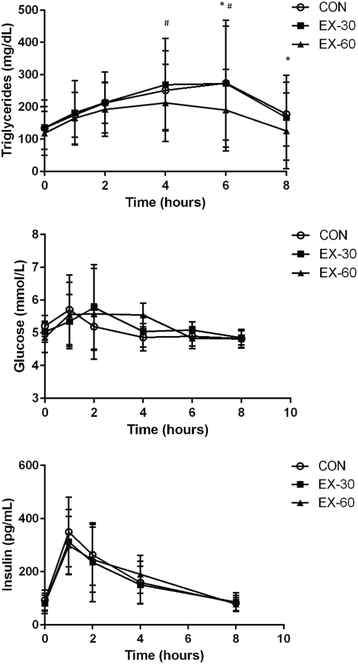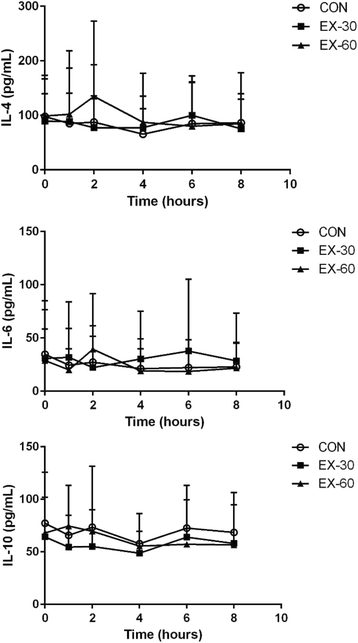Effects of thirty and sixty minutes of moderate-intensity aerobic exercise on postprandial lipemia and inflammation in overweight men: a randomized cross-over study
- PMID: 27366132
- PMCID: PMC4928275
- DOI: 10.1186/s12970-016-0137-8
Effects of thirty and sixty minutes of moderate-intensity aerobic exercise on postprandial lipemia and inflammation in overweight men: a randomized cross-over study
Abstract
Background: The transient rise in blood lipids following a high-fat meal (HFM), known as postprandial lipemia, is linked to systemic inflammation and cardiovascular disease, but can be blunted by exercise. However, minimal research has investigated the effects of realistic exercise bouts on postprandial lipemia and inflammation in at-risk individuals. The purpose of this study was to assess the effects of moderate-intensity aerobic exercise lasting 30 or 60 min performed the evening before a HFM, on postprandial lipemia and inflammation in overweight, insufficiently active men.
Methods: In this randomized-crossover study, twelve participants remained sedentary (CON), or performed a brisk walk on a treadmill at 60 % VO2peak for either 30 min (EX-30) or 60 min (EX-60), after which they consumed a small snack (270 kcal) to partially replace exercise energy expenditure. Following a 12-h overnight fast, participants consumed a standard HFM (1 g fat/kg; 1 g CHO/kg; 1117.8 ± 117.0 kcal). Blood draws were performed at baseline (pre-HFM) and 1, 2, 4, 6, and 8 h post-HFM to assess glucose, insulin, lipids, and systemic inflammation.
Results: There were no significant differences (p > 0.05) in fasting triglycerides between EX-60 (118.7 ± 68.3 mg/dL), CON (134.8 ± 66.2 mg/dL) or EX-30 (135.5 ± 85.4 mg/dL). There were no differences in peak, time-to-peak, total or incremental area-under-the-curve between trials for triglyceride response (p > 0.05). There was no significant main effect of time (p > 0.05) in IL-1ra, IL-4, IL-5, IL-6, IL-10 or TNF-α from baseline to 8 h post-HFM in any trial.
Conclusions: In summary, we found that in overweight, insufficiently active men, neither 30 nor 60 min of moderate-intensity exercise performed 12 h prior to a HFM attenuated postprandial lipemia or inflammation, which could potentially be explained by the partial caloric replacement of exercise energy expenditure.
Keywords: Cytokines; High fat meal; Triglycerides.
Figures



Similar articles
-
Effects of an acute bout of moderate-intensity exercise on postprandial lipemia and airway inflammation.Appl Physiol Nutr Metab. 2016 Mar;41(3):284-91. doi: 10.1139/apnm-2015-0314. Epub 2015 Nov 17. Appl Physiol Nutr Metab. 2016. PMID: 26872295 Clinical Trial.
-
The effect of moderate intensity exercise in the postprandial period on the inflammatory response to a high-fat meal: an experimental study.Nutr J. 2016 Mar 8;15:24. doi: 10.1186/s12937-016-0134-4. Nutr J. 2016. PMID: 26956025 Free PMC article. Clinical Trial.
-
The effect of exercise intensity and excess postexercise oxygen consumption on postprandial blood lipids in physically inactive men.Appl Physiol Nutr Metab. 2017 Sep;42(9):986-993. doi: 10.1139/apnm-2016-0581. Epub 2017 May 30. Appl Physiol Nutr Metab. 2017. PMID: 28558252 Clinical Trial.
-
Postprandial lipemia: factoring in lipemic response for ranking foods for their healthiness.Lipids Health Dis. 2017 Sep 18;16(1):178. doi: 10.1186/s12944-017-0568-5. Lipids Health Dis. 2017. PMID: 28923057 Free PMC article. Review.
-
Effect of Prior Exercise on Postprandial Lipemia: An Updated Meta-Analysis and Systematic Review.Int J Sport Nutr Exerc Metab. 2022 Aug 26;32(6):501-518. doi: 10.1123/ijsnem.2022-0043. Print 2022 Nov 1. Int J Sport Nutr Exerc Metab. 2022. PMID: 36028221
Cited by
-
High fat meals increases postprandial fat oxidation rate but not postprandial lipemia.Lipids Health Dis. 2019 Oct 23;18(1):182. doi: 10.1186/s12944-019-1129-x. Lipids Health Dis. 2019. PMID: 31647036 Free PMC article.
-
The Effect of Resistance, Aerobic, and Concurrent Aerobic and Resistance Exercises on Inflammatory Markers of Metabolically Healthy Overweight or Obese Adults: A Systematic Review and Meta-analysis.Acta Med Philipp. 2024 Nov 29;58(21):90-105. doi: 10.47895/amp.vi0.7315. eCollection 2024. Acta Med Philipp. 2024. PMID: 39758295 Free PMC article.
-
Postprandial Metabolic Responses Differ by Age Group and Physical Activity Level.J Nutr Health Aging. 2018;22(1):145-153. doi: 10.1007/s12603-017-0956-6. J Nutr Health Aging. 2018. PMID: 29300434
-
Acute Exercise and the Systemic and Airway Inflammatory Response to a High-Fat Meal in Young and Older Adults.Metabolites. 2022 Sep 10;12(9):853. doi: 10.3390/metabo12090853. Metabolites. 2022. PMID: 36144256 Free PMC article.
-
Recreational football practice attenuates postprandial lipaemia in normal and overweight individuals.Eur J Appl Physiol. 2018 Feb;118(2):261-270. doi: 10.1007/s00421-017-3766-y. Epub 2017 Dec 6. Eur J Appl Physiol. 2018. PMID: 29214463 Clinical Trial.
References
Publication types
MeSH terms
Substances
LinkOut - more resources
Full Text Sources
Other Literature Sources
Medical
